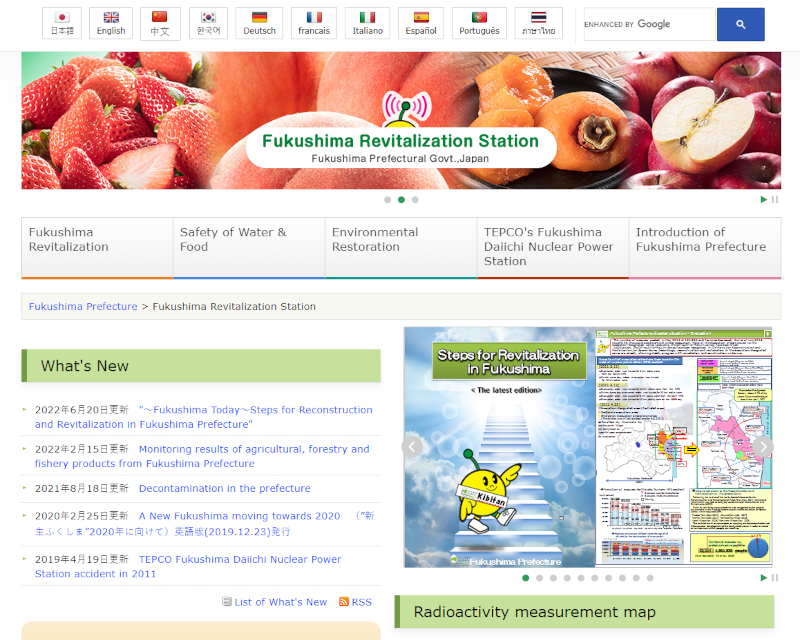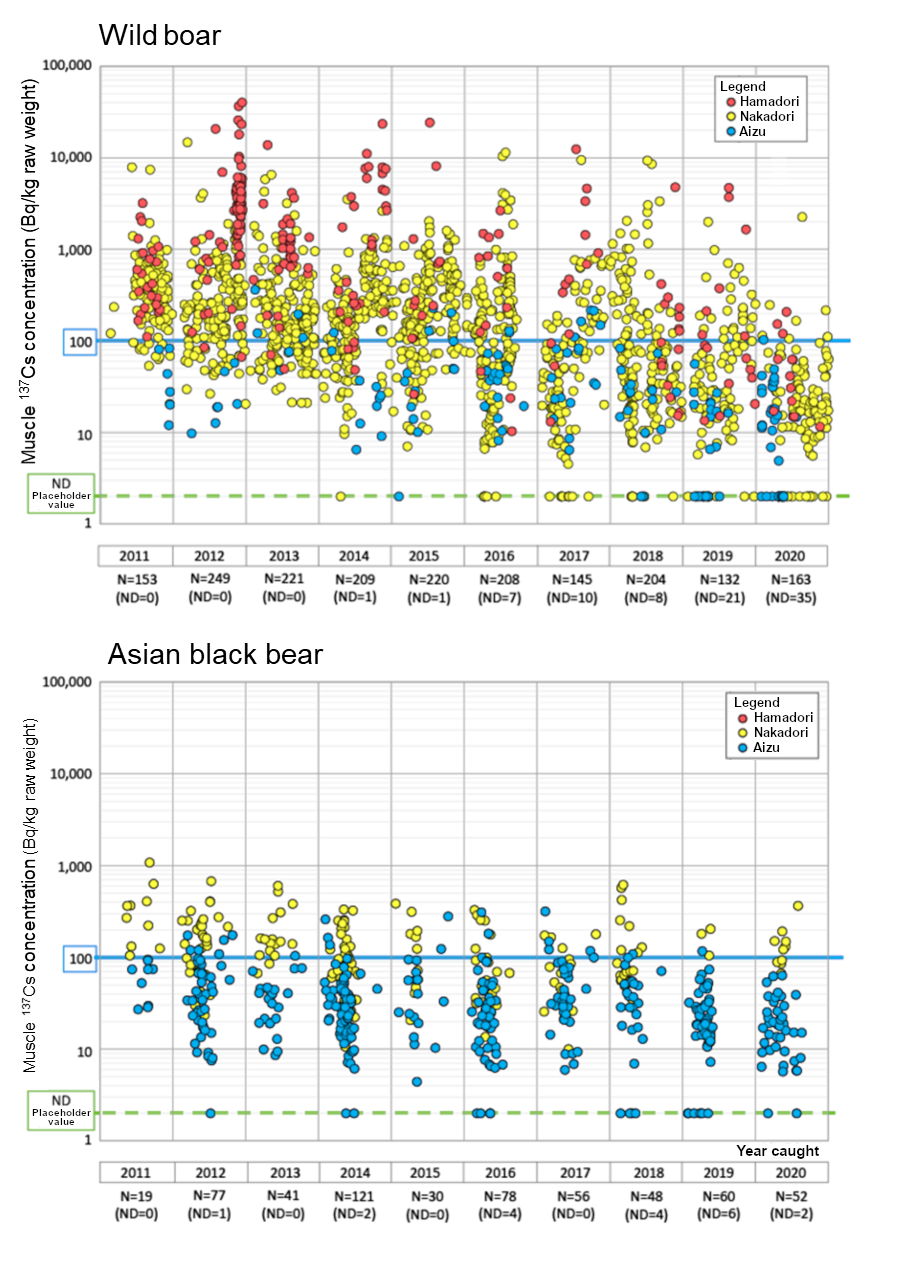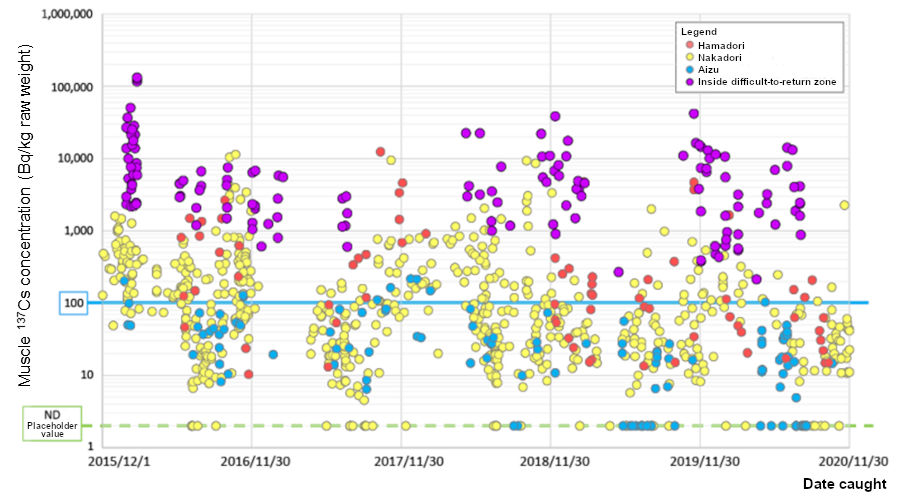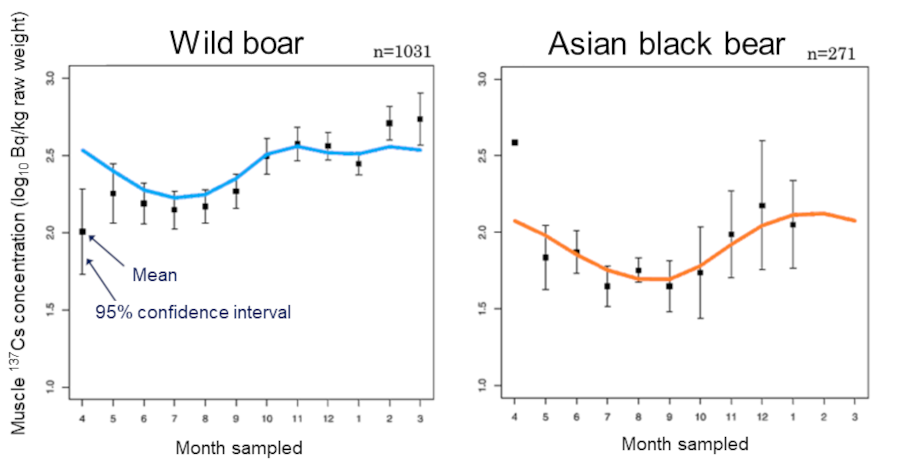Effects on Ecosystem
(2021)
QHow have the radioactive Cs concentrations changed in wild animals in Fukushima prefecture?【Recent trend】
AThe 137Cs concentration in the muscle of wild boars and Asian black bears sometimes exceeds the standard values even now.
The muscle 137Cs concentration of wild boars in the difficult-to-return zone tends to be higher than those outside the zone.
Wildlife radiation monitoring surveys
The Section of Nature Protection, Fukushima Prefecture has been conducting sampling of muscle from wild birds and beasts caught by hunting, etc. (mainly those hunted for consumption, including wild boar, Asian black bear, shika deer, pheasant, copper pheasant, ducks, and hare) and measurement of radionuclide concentrations. The results of measurement are available on the website of Fukushima Prefecture.


Fukushima Prefecture website “Fukushima Revitalization Station” Wildlife radiation monitoring survey results (Japanese only)

Fig. 1 Temporal change in muscle 137Cs concentrations in wild boar and Asian black bear
Some wild boars and Asian black bears exhibit muscle 137Cs concentrations below the lower limit of detection, while some other individuals exhibit values exceeding the standard value for food (100 Bq/kg as a total of 134Cs and 137Cs) even in recent years.
Muscle radioactive cesium concentration in wild boars in difficult-to-return zone
The wildlife radiation monitoring surveys are conducted for areas other than the difficult-to-return zone. One of the possible reasons why some wild boars show high radioactive Cs concentrations outside the difficult-to-return zone is movement of wild boars from the difficult-to-return zone. To find that out, a survey was conducted on radioactive Cs concentrations in wild boars inside the difficult-to-return zone.

Fig. 2 Monitoring results of muscle 137Cs concentrations in wild boars
(FY2020 Report Session for Study on Effects of Radiation on Wild Animals and Plants, Rie Saito “Five years of monitoring of radioactive cesium in wild boars captured within difficult return zone area in Fukushima Prefecture”)
As a result, it was found that the radioactive Cs concentrations greatly varied individual to individual inside the difficult-to-return zone as well. Also, wild boars captured inside and around the difficult-to-return zone tended to show higher radioactive Cs concentrations than those captured outside the difficult-to-return zone.
Future studies

Fig. 3 Seasonal variation in muscle 137Cs concentrations in wild boar and Asian black bear
(Nemoto et al.,2018,PLoS ONE)
A study found seasonal variations in the muscle 137Cs concentrations in wild boars and Asian black bears, possibly due to their feeding habits and behavior. The researchers are planning to seasonally investigate the content of the beasts’ stomach, the fauna and flora in their habitat, and their behavior to reveal how these factors affect muscle 137Cs concentrations.
(Research results from the Fukushima Prefectural Centre for Environmental Creation and others. Reproduced from the website of the Fukushima Prefectural Centre for Environmental Creation (partly edited by JAEA))
Related articles
- How have the radioactive Cs concentrations changed in wild animals in Fukushima prefecture?
- Is there any increase in the number of mutations caused by radiation among wildlife in Fukushima prefecture?
- How have ecosystems changed in evacuation-order zones?
- Where is radioactive cesium is deposited in forests? How much? How does the amount change with time?
- How do air dose rates in forests change with time?
References
- Nemoto, Y., Saito, R. and Oomachi, H. (2018): Seasonal variation of Cesium-137 concentration in Asian black bear (Ursus thibetanus) and wild boar (Sus scrofa) in Fukushima Prefecture, Japan, PLOS ONE, vol. 13, no. 7, e0200797. https://doi.org/10.1371/journal.pone.0200797
- Saito, R., Kumada, R., Inami, K., Kanda, K., Kabeya, M., Tamaoki, M. and Nemoto, Y. (2022): Monitoring of radioactive cesium in wild boars captured inside the difficult-to-return zone in Fukushima Prefecture over a 5-year period, Scientific Reports, vol. 12, 5667. https://doi.org/10.1038/s41598-022-08444-1
